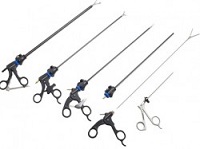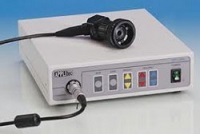Minimal Access Surgery (MAS) / Laparoscopic Surgery in India
What is Minimal Access Surgery (MAS) / Laparoscopic Surgery in India
Laparoscopic Surgery /Minimal Access Surgery/MAS is the technique where surgeries are performed by inserting a video camera and multiple thin instruments in the body through small holes/incision. The camera or the end vision system, as it is technically called , visualises the whole abdomen and the surgeon performs the surgery by looking at a monitor/TV screen.
“Thus the camera replaces the surgeon’s eye”.
Laparoscope primarily consists of two sets of instruments:-
-
Hand instruments for Minimal Access Surgery / Laparoscopic Surgery
-
Endovision system for Minimal Access Surgery / Laparoscopic Surgery
-
Hand Instruments:
These are slender instruments with long and thin bodies. They come in various sizes and shapes. Unlike conventional surgery where long and lightly incision are made, Laparoscopic Surgery is done by making tiny holes in the body (0.5- 1 cm) and inserting instruments through them.

-
Endovision System:
It consist of telescopes, camera, light source etc. With improvement in the quality of endovision system, the surgical skills in Laparoscopy have improved tremendously. Presently, high definition (HD) systems are in use but may be soon replaced by 3 D vision system which will further increase the quality and safety of Laparoscopic procedures.

ADVANTAGES OF
Minimal Access Surgery (MAS) / Laparoscopic Surgery in India?
Minimal Access Surgery (MAS) offers several advantages over conventional surgery; they can be broadly classified as:
- Advantages for the Patient.
- Advantages for the Doctor.
ADVANTAGES FOR THE PATIENT:
- The most important advantage from the patient’s point of view is COSMESIS. As incisions are very small the scars are almost invisible. Thus patients are happy that they don’t get ugly looking scars on their bodies.
- Since the size of incision is small this healing is quicker and patient is up within few hours after surgery. In conventional surgeries however it may take 2-3 or even more days for the patient to become fully mobile.
- Early recovery automatically means the amount of pain is decreased substantially. Thus psychologically it is a big boost for the patient.
- Most patients, undergoing Minimally Access Surgeries are fit to resume work after 7-10 days thus it is a big economic benefit for them as well as their employees.
ADVANTAGES FOR THE DOCTOR:
It should be made clear, right at the beginning that these advantages are also ultimately beneficial to the patients, but have been placed under a separate heading as being a layman, patients normally don’t realize their importance.
- Laparoscopy gives a very large and magnified view to the surgeon as the camera can be directed to virtually any part in the body. This is not possible in open surgeries as the area that is best seen is the one directly under the incision.
Hence, in doubtful cases the certainty of diagnosis increases and any co-existent pathologies are also picked up.
- Second look surgery is always possible. If due to the extent of the disease or poor general condition of the patient, a procedure is not completed satisfactorily, it always leaves a chance for operating upon the patient at a later date. Thus the patient doesn’t have to undergo a major surgical trauma again.
- In certain cases e.g. advanced cancers, where disease has spread beyond surgically curable limits, surgeons can safely abandon the procedure after having a look, thus avoiding a major incision on patient’s body.
- As all these procedures involve the use of cameras they can be recorded on videotapes /CDs or hard disks. These recordings are beneficial later for second opinion and even offer legal protection to the surgeon himself, saving him from false allegations.
- Last but not the least, as incisions are very small thus all the problems related to large incisions e.g. infection, pain in scars and hernia formation etc are decreased to a large extent.
DISADVANTAGES & LIMITATIONS OF
Minimal Access Surgery (MAS) / Laparoscopic Surgery in India
Like all things in life, the Minimal Access Surgery also has some negative points. Unlike conventional surgery where skill of the surgeon is the most important factor responsible for success/failure of a surgery, MAS is dependent upon two factors:
- Surgical Skill and experience of the surgeon.
- The quality and state of the technology.
- It is absolutely imperative that only latest and state of the art equipment should be used for these procedures. If the equipment is outdated or malfunctioning, however skilled may be the surgeon, he/she won’t be able to deliver the goods.
- As the success of these procedures depends largely on high technology equipment usage, the cost of the procedure becomes slightly higher. However with advent of new and indigenous technologies, cost of many procedures has come down dramatically, and it is sincerely believed that, cost of the remaining surgeries will also come down.
- One has to be careful in selecting the surgeon. Mere acquisition of the equipment doesn’t make anybody a trained Laparascopic surgeon. Thus these procedures should be done only by those who have had adequate experience by working under supervision of trained Laparascopic Surgeons.
MYTHS ABOUT
Minimal Access Surgery (MAS) / Laparoscopic Surgery in India
a) Incomplete procedures ! Thereby leading to reoccurrence of problem
This is not true as the procedure in both open and Laparoscopic Surgery is almost the same. It is only the technique which is different. Thus if properly performed, these procedures are equally effective as compared to conventional surgeries.
b) Higher Complication Rate
This myth has taken ground because complications increase when surgeons embark upon these procedures without proper training. However in trained hands, the complication rate for any procedure is comparable to that in conventional surgery.
c) Very Costly
The cost of these procedures is only marginally higher and if one looks from another angle that patients are able to return to their livelihood very early, it amounts to rather less overall cost to the patient.
d) All surgeries can be done laparoscopically !!
No, it is not true. It is so because MAS is extremely technology dependent and with improvements and new inventions occurring in instruments almost everyday, the range of surgery is increasing very rapidly. A day may come when everything will be done by MAS only, but as of today, it has its limitations.
e) All patients with same problem can be done with MAS
No it is not only the type of disease but also the extent of disease and general condition of the patient, which determines whether he can be safely operated upon by Minimally Invasive Procedures. Thus which patient should be operated by this technique should be best left to the surgeon.
